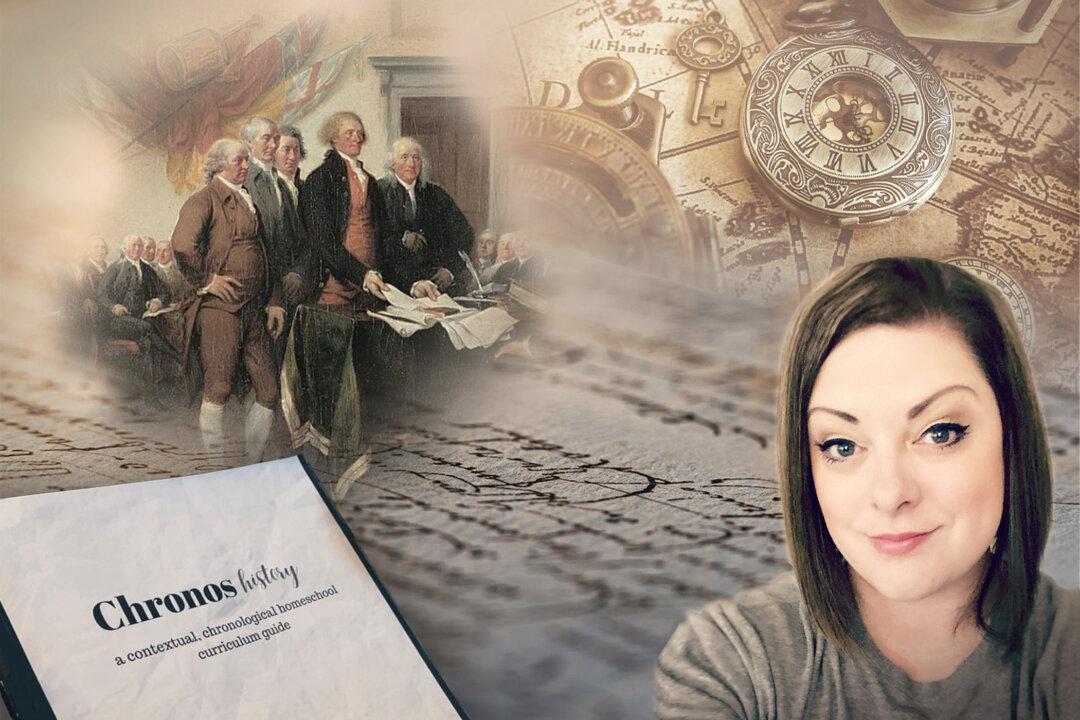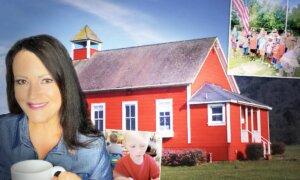A homeschooling mom with a deep concern for historical literacy in the United States has turned her expertise into a solution—a homeschooling history curriculum that breaks the mold of the classes taught in conventional schools.

The Curriculum
The mom of three, who has “always done some sort of curriculum development” with her children, felt that curriculum writing was a natural next step. Over five years, she put together “Chronos,” a curriculum guide for teaching history to kids from kindergarten through 8th grade.Chronos consists of 32 lessons covering topics from the Stone Age through to present-day events, in chronological order.
“It begins with world history, narrows to Western Civilization after the fall of Rome, and then narrows again to American history after the Age of Exploration. ‘Chronos’ is meant to be repeated every year, from kindergarten through 8th grade, so that students entering high school have a very solid grasp of chronology and historical context,” she said.
Mrs. Metesh, who is a Christian, says she aims to state “just the facts” even though, whenever appropriate, she does include resources on Biblical and church history, as would any historian, but she makes “no attempt to sway anyone” towards her own political, philosophical, or theological views.
A “product of the public school system” herself, when Mrs. Metesh found herself wanting to keep up with the public school curriculum in terms of scope and sequence, she made a conscious choice to “stop thinking like an educator and start thinking like a historian.”
“The ‘past’ consists of historical fact, things we can prove and about which there is little or no dispute, and ‘history’ is how historians have interpreted or explained those facts,” she told The Epoch Times. “History fills in the blanks and tells the story, and whoever is telling the story controls how it’s told.
“My curriculum guides seek to offer many varied interpretations using several different methods of information—primary and secondary sources, web articles, YouTube, documentaries, tertiary sources, even library books of historical fiction—so that students can sample the interpretations that exist and come up with their own conclusions. ... Complete neutrality may not be possible, but we can get close.
“It’s chronological and contextual, not thematic. We’re used to being taught these disjointed, decontextualized pieces of the past; they’re chopped up into units like ‘Community Helpers,’ or ‘National Symbols’ when we’re in elementary school, and then cover certain periods of time in the later grades, but none of it connects. There’s no cohesive, chronological curriculum out there which helps students see how events evolved and what the immediate and long-lasting effects were.”

Mrs. Metesh studied historiography in her junior year of college and remembers being “completely blown away” by the concept of historical interpretation. It dawned on her that the average reader was not part of this exclusive world but would simply “regurgitate things which trickled down into curriculum from these powerful interpreters.”
Her children have always been homeschooled, but Mrs. Metesh has also taught children who were formerly in the public school system and can see a huge difference.
“Kids learn what they need to learn, take a test, and forget what they learned because it doesn’t seem to matter in real life, or connect to their life in any way,” she said. “Homeschool and ‘Chronos’ operate completely differently and therefore produce different results; [the kids are] more naturally curious, they’re free to ask questions, and we always investigate the connections and cause/effect.”
“For a while, it was like I was shouting my thoughts into the void, and then I started getting followers out of nowhere,” Mrs. Metesh said. “[W]ith more views comes more criticism; I’ve been called names, and had to block random internet trolls ... But all in all, the reaction has been positive.
“Many people say their kids have gone from dreading history to being excited about it, and one of the most common messages I receive is how often families are now seeking out historically immersive experiences like museums and reenactments. Parents have told me how they feel much more confident in teaching their children, which is probably the most encouraging. ... It’s been an amazing experience.”








